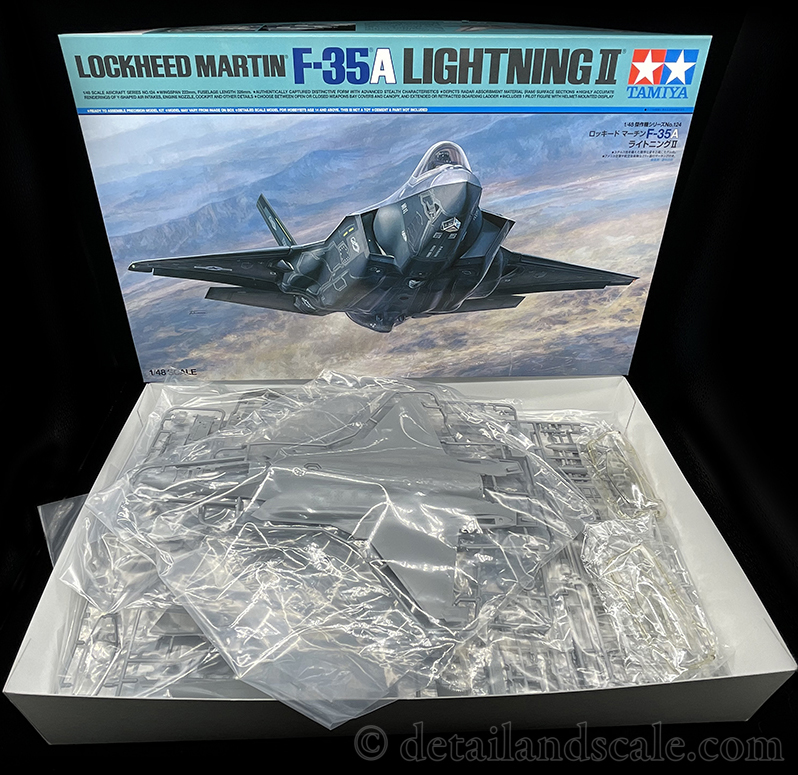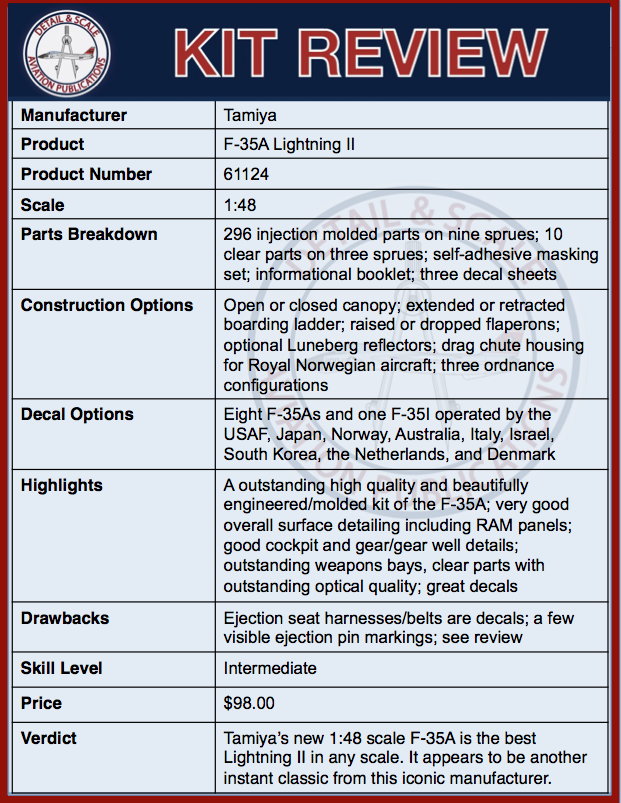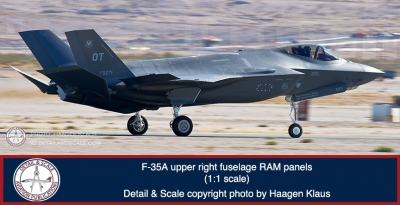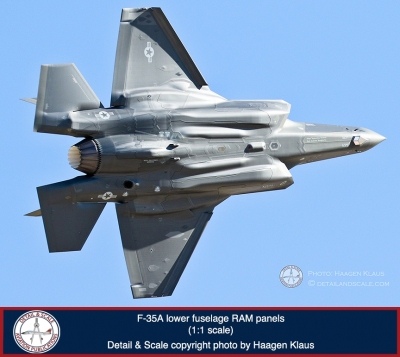Tamiya # 61124
Lockheed Martin F-35A Lightning II


Today, the F-35 Lightning II is the most technologically advanced combat aircraft ever developed. The F-35A is the USAF’s conventional takeoff and landing variant. It brings remarkable fifth generation fighter technology to the air combat and ground attack arenas. A few 1:48 scale kits of the F-35A have come onto the market over the last decade or so, but they often left things to be desired. In 2022, Tamiya surprised the scale aircraft modeling world with news of their impending release of a 1:48 scale F-35A kit. A pre-release sample of the kit just landed on Detail & Scale’s review bench. Let’s check it out.

Following the end of the Cold War, many U. S. combat aircraft development programs were cancelled, scaled back, or merged. Still, successors were needed for the F-16 Fighting Falcon, A-10 Thunderbolt II, A-6 Intruder, AV-8B Harrier, and F/A-18 Hornet. The Joint Strike Fighter (JSF) program emerged in 1995 to fill these needs. The program represented the prospect of billions in revenue for contractors and the production of thousands of aircraft. The JSF was ambitious and called for a single airplane (where commonality would reduce cost) to meet the future needs of the Air Force, Navy, and Marine Corps, along with those of NATO member nation air arms. In 1996, proposals by Boeing and Lockheed Martin were selected to be developed into JSF demonstrators. From 2000-2001, Boeing’s X-32A and Lockheed Martin’s X-35A took part in a fly-off competition at Edwards AFB. In October 2001, the X-35A was declared the winner and the development of a production version began by Lockheed Martin and eight partner countries.
The conventional takeoff and landing (CTOL) F-35A is a fifth-generation multirole combat aircraft, leveraging advanced low observable (or stealth) technology, sensor fusion, and other highly advanced avionics to maintain air dominance and conduct precision strike missions. Unclassified sources state the F-35A’s radar signature is about equal to that of a golf ball. Up to 5,700 pounds of ordnance can be carried in a pair of internal weapons bays. For missions where stealth is not required, another 15,000 pounds of stores can be distributed across the lower wing pylons. The mighty Pratt and Whitney F-135 engine provides up to 43,000 pounds of thrust and a top speed of Mach 1.6. Since it lacks vectored thrust, the F-35A is not super-maneuverable like the F-22. Its flying characteristics have been described as on par with an F-16 or F/A-18, especially when external stores are loaded. The cockpit features a huge digital touchscreen display panel and voice command recognition. The traditional HUD has been replaced by the pilot’s far more advanced helmet mounted display that is a unique human-machine interface. Onboard computers fuse all electro-optical and radar data (with the latter provided by the advanced AN/APG-81 AESA radar) to produce an unprecedented three-hundred-and-sixty-degree sphere of situational awareness. All sensor data can be shared with other F-35s or similar platforms via an advanced network datalink. The F-35A also fields the internal GAU 22/A 25 mm cannon.
F-35A AF-1 rolled off the Lockheed Martin production line in Fort Worth in 2006. It was the first of more than 1,700 F-35As planned for the USAF. The F-35A was named “Lightning II” in honor of the World War II-era P-38. The F-35’s early years were mired in controversy, billions of dollars worth of cost overruns, and unexpected redesign work. As the F-35 matured, problems were solved and new capabilities were (and continue to be) incrementally added. The USAF declared Initial Operational Capability when Block 3i F-35As joined the 34th Fighter Squadron at Hill AFB, Utah, in 2016. Since then, deliveries have continued, more squadrons are standing up, operating costs are decreasing, and the F-35A’s systems and tactics continue to develop. The first combat deployment of the F-35A was in 2019 to the UAE where F-35As conducted airstrikes on Islamic State targets in Iraq. Deliveries of additional F-35As continue to the USAF, Japan, Italy, South Korea, Israel, and others.

Tamiya’s 1:48 scale F-35A Lightning II kit comes on nine injection molded polystyrene sprues containing 296 parts. Another 10 clear parts come on three clear sprues. The kit also contains a self-adhesive canopy masking set. The black-and-white color instruction booklet organizes the build over 59 steps. A multi-language booklet on the F-35 provides background information for the aircraft. Markings for nine airplanes are included on three decal sheets:
- F-35A 13-5071, USAF, 34th FS, 388th FW, Hill AFB, Sept. 17, 2015
- F-35A 89-9710, JASDF, 30nd FW, 3rd Wing, Misawa AB, 2022
- F-35A 5149, Royal Norwegian Air Force, 332nd Squadron, 132nd WG, Keflavik, AFB, March 2020
- F-35A A35-009, Royal Australian Air Force, No. 3 Sq. Commander’s Aircraft, No. 81 WG, RAAF Base Williamtown, December 1, 2018
- F-35A F-023, Royal Netherlands Air Force, Leeuwardden Air Base, April 2022
- F-35A MM 7362, Italian Air Force, 13th Squadron, 32nd Wing, Amendola Air Base, 2021
- F-35I Adir 928, Israeli Air Force, 116th Squadron, Nevatim AB, August 2020
- F-35A 19-007, Republic of Korea Air Force, 152nd Fighter Squadron, 17th Fighter Wing, Cheongju Air Base, 2021
- F-35A L-001, Royal Danish Air Force, Lockheed Martin Fort Worth Plant, Texas, March 8, 2021
Strengths: Tamiya is highly regarded as the best plastic model maker in the world, holding up a standard involving high accuracy, great detail, and exceptional kit design and fit. With every new release, they seem to define another standard in the hobby. The same appears to be true with their new F-35A, which has been in development over the last five years. This is the best F-35A kit available in any scale by far, and it definitively outshines all other F-35A kits in 1:48 scale.
Tamiya has produced a beautifully engineered kit with this F-35A. It is not over-engineered and is designed for ease of construction. The parts count is very manageable. I snipped off several major parts (e.g., fuselage/wings, vertical stabilizers, nose). Dry-fitting these items revealed literally perfect, seamless fits.
The quality of molding is sublime. The panel and surface feature detail is sharply executed. Of course, the top, sides, and bottom of the F-35 are covered in various kinds of RAM (radar absorbing material) and conformal antennas. Many manufactures have chronically represented RAM panels on F-22 and F-35 kits in an extremely over-scaled manner. Here, Tamiya gets really close to perfect. There has been some online chatter and controversy claiming that Tamiya erred in their representation of F-35A surface details. Inspection by your reviewer’s “Mark I Eyeball” indicates this is not the case…mostly. I do, however, think that some of Tamiya’s representations of the RAM panels are indeed a little too high. Before moving on, let us pause for a moment and think carefully about this issue.
When comparing 1:1 scale versus 1:48 scale, I have found that the 1:1 scale F-35 RAM panels can be visually deceptive. Your reviewer has been shooting photos of F-35s in detail for several years. Under most daylight conditions, the RAM panels can appear nearly conformal to the aircraft’s skin. This was especially true with the lighter color/higher contrast first generation RAM (see below). Under other lighting conditions, and especially when shadows hit them just right, the raised RAM panel height is quite apparent. In the photo gallery below, I have included a few pictures of the 1:1 scale F-35A as points of comparison. In this kit, RAM panel height on the forward upper fuselage areas does appear, in my honest objective opinion, to be just a bit too high – but it is not significantly out of proportion. The 1:1 scale RAM panels are higher on the aft upper fuselage, lower fuselage, and lower wing pylons covers, and these appear rather accurately represented by Tamiya. In sum, this kit probably does possess the best scale representation of the F-35’s surface details seen so far in a plastic model. When examined visually and by touch, Tamiya’s RAM panels are certainly more restrained and subtler than that in the Kitty Hawk or Meng kits (I have not yet seen the Italieri 1:48 scale F-35B to comment on it). Bottom line: what we have here on the Tamiya F-35A will appear just fine in 1:48 scale, especially following a few coats of primer, paint, and a panel line wash.
The cockpit is well detailed. The instrument panel and side consoles are nicely represented, including the 22-inch LCD display that is the dominant feature of the pilot’s instrument console. Cockpit sidewall detail, rudder pedals, sidestick controller, and arm rest all look complete. Alternate instrument panel and side console decals are provided if that is the builder’s preference. The next-generation Martin-Baker US16E ejection seat builds up out of 11 separate parts, allowing for a high level of detail. The pilot figure also has a good level of detail, depicting the helmet-mounted display and other unique F-35 flight gear details. Arms are molded in position for the pilot to be holding the control stick and working the throttles – a bit more dynamic than some Tamiya pilot figures in the past. Other features of the forward fuselage include an optional open or closed integral boarding ladder and nicely detailed sensors and sensor windows for the EOTS (or the AN/AAQ-40 Electro-Optical Targeting System) under the nose. Full air inlets are provided and lead to the blades of the F135 engine’s first stage compressor.
One absolutely eye-popping feature of this kit involves the weapons bays. The detail here rivals cast resin. It appears to be a very faithful recreation of the 1:1 scale bays. All the structural details, piping, pumps, actuators, bomb and missile racks, boxes, and plenty of wiring are all present. There’s not really that much to add. Detail painters are going to love working on this part of the kit. Alternate parts are provided for open and closed weapons bay doors. The gear wells and landing gear are another highlight of the kit. Again, the quality of detail is outstanding, though the builder can add landing gear wiring and hydraulic lines.
Mid- and aft fuselage details include four optional Luneberg reflectors, attached to the F-35A when it needs to be radar-observable (e.g., stateside training missions) or when it needs to disguise its low-observable characteristics should unfriendly eyes be watching (e.g., patrolling over eastern Europe following the Russian invasion of Ukraine). The serrated engine nozzle is built up from of five pieces and looks quite nice. Alternate parts are provided for either raised or dropped flaperons. While the leading edge slats are separate parts, the can only be attached straight in, or in the neutral position.
The kit comes with two AIM-9Xs, two AIM-120Cs, two GBU-31 two-thousand-pound JDAMs, and four GBU-12 Paveway II laser-guided bombs. All the missiles and bombs appear well made and accurate. There are three options for ordnance configurations: stealth mode (AIM-120Cs and GBU-31 JDAMs in the internal bays), air-to-air mode (AIM-120Cs in the bays and AIM-9Xs on outboard wing pylons), and the aptly named beast mode (AIM-120Cs and GBU-31s in the bays, outboard AIM-9Xs, and four GBU-12 LGBs under the wings). Note that hanging any external stores will require a little work opening up mounting holes on the inside lower wing surfaces to attach the pylons.
The clear parts are absolutely beautiful. Their optical quality is flawless, and I would be afraid to dip them in Future or even polish them. Three single-piece canopies are provided. One is a simple clear canopy (should the builder wish to tint it themselves), and the other two are tinted amber approximating the anti-radar coatings on the canopy. A second tinted canopy is included if the builder would like to switch from an open canopy (which can be lifted out but not closed due to the mounting hardware) to a closed canopy (which will drop on down) while displaying the finished model. A masking set is there to assist in the painting of the canopy, EOTS windows, and a few other spots. However, these masks are not pre-cut.
The decals are another impressive element of Tamiya’s F-35A. It looks like Tamiya printed them in-house and they appear to be technically flawless. The markings options capture the multi-national nature of the F-35A. To my knowledge, every current F-35A operator is represented here, from the USAF to the JASDF, RAAF, ROKAF, and more. Note that the F-35I is an F-35A operated by Israel but contains their electronic warfare systems. The Royal Norwegian F-35s feature a low-profile drag chute housing on the upper aft fuselage, and this part is included in the kit. A small decal sheet contains all the stencils for the aircraft, landing gear placards, the speckled top of the helmet mounted-display, and all the ordnance. Even some bare metal parts of the airframe may be represented by decals. The largest decal sheet in the kit contains nothing but RAM panels. This detail is important. Some of the paint schemes in this kit represent the first generation of F-35A coatings (called RAM Coating Early Version in the kit) that were of a much lighter color than the overall paint scheme and they really stood out. Other markings options represent the current second generation of RAM panels where most of them are of the same color as the aircraft’s paint, and color contrast is significantly minimized. RAM panel decals are supplied for both first and second generation coatings, making the scale modeler’s life a lot easier not having to conduct a massive and intricate masking job on their own.
Weaknesses: There are very few potential shortcomings, some of which boil down to personal preference. Given the way the air inlet parts come together, there will be fine seams in the top and bottom of the intake ducting that many builders will want to fill and sand smooth. I am also not a fan of the US16E ejection shoulder harnesses and lap belts being represented as decals. They will always look better as separate photoetched or 3-D printed parts. Keep an eye out for ejection pin markings. There are not all that many of them in this kit, but there are some subtle, shallow pin markings on the inside surfaces of some parts. They will be hard to see in the completed model, but will be present, nonetheless.

The Tamiya 1:48 scale F-35A Lightning II appears to be an outstanding model kit, and looks like it will join their legendary 1:48 scale F-14 and F-4B kits. It outdoes the fidelity, detail, and engineering of all other F-35 kits in all scales. It is somewhat expensive, but here, quality translates into price. We have high hopes that Tamiya will produce F-35B and F-35C kits in the future…one might speculate as to why there are gaps in the alphabetical sequence of the sprues in this F-35A kit. It suggests at least the possibility of future releases. If you wish to add even more detail to your Tamiya F-35A, all the major aftermarket manufacturers should be releasing detail sets soon, and Furball Aero-Design already offers a few 1:48 scale F-35A decal sheet sets. However you proceed, we think you will really enjoy building this kit.
We thank Tamiya America and Fred Medel for their generosity in sharing this review sample with us. You can find them on the web at https://www.facebook.com/TamiyaUSA on the web at www.tamiyausa.com.
Haagen Klaus
Scale Modeling News & Reviews Editor
Detail & Scale




